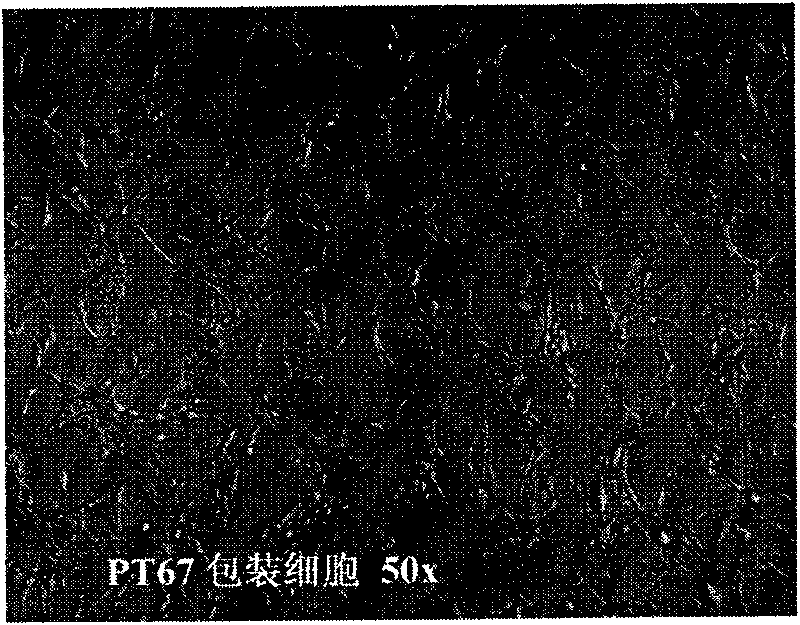Method for transfecting bovine somatic cells into inducted pluripotent stem cells by adopting transcription factors
A technology of pluripotent stem cells and transcription factors, applied in botany equipment and methods, biochemical equipment and methods, cells modified by introducing foreign genetic material, etc., can solve the problem of increasing workload and difficulty, affecting the clinical application of ESCs cells, etc. problem, to avoid the effect of heterogeneous animal cell contamination
- Summary
- Abstract
- Description
- Claims
- Application Information
AI Technical Summary
Problems solved by technology
Method used
Image
Examples
Embodiment 1
[0052] Isolation and cultivation of bovine skin fibroblasts of embodiment 1
[0053] Adult bovine dermal fibroblasts (BDFs) were isolated from the ear margin skin of adult female Holstein cows. After the tissue was cleaned and sterilized, it was cut into small tissue pieces, and cultured in high-sugar DMEM (Gibco company product) containing 15%-20% fetal bovine serum (FBS) (Gibco company product) under conventional culture conditions. The culture solution was changed every 2-3 days. After 7-10 days, fibroblasts moved out from the edge of the tissue block, and after 12-16 days, a large number of fibroblasts were closely arranged around the tissue block. Digested with trypsin and EDTA mixed digestive juice and passaged, a large number of adult bovine skin fibroblasts were obtained, see figure 1 . Newborn bull skin fibroblasts (male newborn bovine dermalfibroblasts, NDFs) come from Holstein breed newborn bull ear margin skin, see figure 2 , the method of isolation and culture...
Embodiment 2
[0054] Example 2 Cloning of key gene transcription factor for bovine maintenance of pluripotency and construction of its retroviral vector
[0055] Genital ridges were isolated from fetuses of 50-60-day-old Holstein cows, and the total RNA was extracted with TRIzol LS Reagent after tissue homogenization, and treated with DNaseI (RNase free) to remove genomic DNA contamination. cDNA was obtained by reverse transcription reaction. Then, using cDNA as a template, the complete sequences of the open reading frames (ORFs) of Oct4, Sox2, c-Myc and Klf4 were amplified by PCR respectively. The primer sequences used for gene cloning are shown in Table 1.
[0056] Table 1 The information of the primers used to amplify the four genes of bovine Oct4, Sox2, c-Myc and Klf4
[0057]
[0058]
[0059] The cycle parameters of Oct4 gene PCR amplification are: pre-denaturation at 94°C for 5 min, denaturation at 94°C for 45 sec, annealing at 60°C for 45 sec, extension at 72°C for 1 min, 35 ...
Embodiment 3
[0065] Packaging and preparation of embodiment 3 retrovirus
[0066] PT67 packaging cells were cultured in DMEM medium according to conventional methods. When the cells reached 70%-80% confluence, liposomes were used to transfect retroviruses into packaging cells PT67 cells for virus packaging to obtain infectious retroviruses. virus particles. 1 hour before transfection, DMEM medium was replaced with serum-free medium, 4-8 μg retroviral plasmid DNA and 10-20 μl liposome were added to 500 μl Opti-MEM-I+GlutaMAX-I (Gibco company product) optimization Gently mix in the transfection solution, incubate at room temperature, then gently mix the diluted plasmid DNA and liposomes, and incubate at room temperature for 20 minutes, then add the mixture dropwise to the PT67 cell culture dish. Cells at 37°C, 5% CO 2 After culturing for 4-6 hours under saturated humidity conditions, the transfection solution was replaced with a new DMEM culture solution containing 15% FBS. After 24 hours...
PUM
 Login to View More
Login to View More Abstract
Description
Claims
Application Information
 Login to View More
Login to View More - Generate Ideas
- Intellectual Property
- Life Sciences
- Materials
- Tech Scout
- Unparalleled Data Quality
- Higher Quality Content
- 60% Fewer Hallucinations
Browse by: Latest US Patents, China's latest patents, Technical Efficacy Thesaurus, Application Domain, Technology Topic, Popular Technical Reports.
© 2025 PatSnap. All rights reserved.Legal|Privacy policy|Modern Slavery Act Transparency Statement|Sitemap|About US| Contact US: help@patsnap.com



